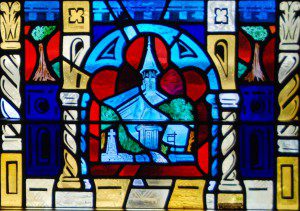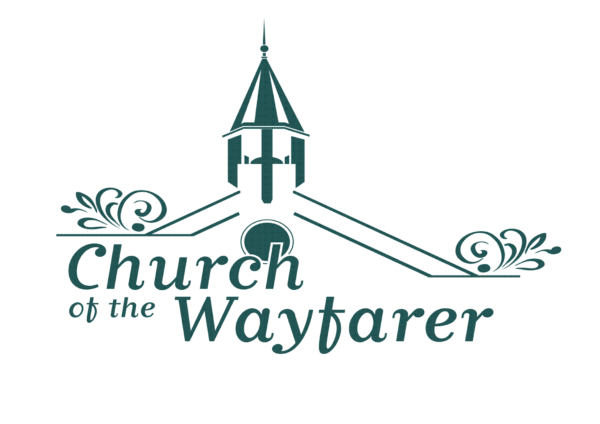Front Nave Window
First Lancet
The Manager Scene (Luke 2 and Matthew 2).
Mary is adoring the baby, Jesus.
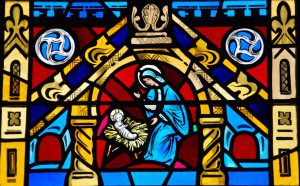
Elijah on Mt. Carmel (1 Kings 18:20)
In contention with the prophets of Baal, Elijah builds an altar with twelve stones (v. 31) and surrounds it with a trench filled with water (v. 35) yet the fire from God consumes the wood while the altar of the Baals remains unkindled. Two seagulls adorn the window.
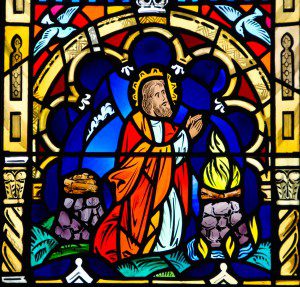
Johann Sebastian Bach (1685-1750)
He sits at the organ console. The Chi Rho symbol stands for Christ while the SDG is Bach’s notation used so often on his manuscripts, “Soli Deo Gloria”.

St. Agustine (354-430)
One of the four great fathers of the Latin church, he is depicted sitting at his desk writing his theological masterpiece, “City of God”. The heart aflame transfixed by arrows stands for Agustine’s fervent love of Christ transfixed by poignant remorse for past sin. In the decorative margin are a cypress tree and a Monterey pine.
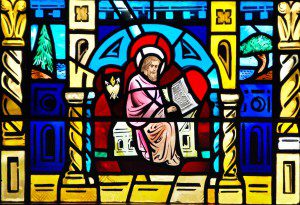
Second Lancet
Jesus in the Temple (Luke 2:46-48) Jesus is depicted at the age of twelve among the teachers, listening to them and asking them questions.
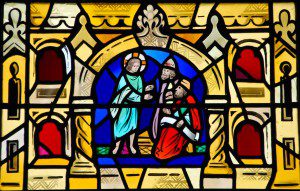
The Tree of Jesse (Ruth 4:21, Matthew 1, Ruth 2:1ff, Isaiah 11)
This window depicts the genealogy of Jesus. From Jesse’s loins springs his son, King David, wearing a crown and holding a harp. Ruth, the Moabite woman is holding the ears of a grain. She will marry Boaz, and become King David’s great grandmother, all of whom are the ancestors of Jesus. The seven doves stand for the seven gifts of the spirit.
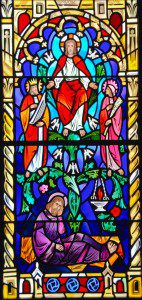
St. Boniface (673-754)
St. Boniface is cutting down the oak of Geismar and thus challenging the pagan religion of Germany. The fir tree in the background is to become the tree of the Christians, pointing to heaven. The saint’s martyrdom is depicted by the sword piercing the book when he was attacked in Friesland where, at his death, he held the book over his head to preserve it from the sword blows.
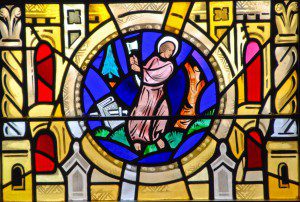
Third Lancet
Jesus being baptized (Mark 1:9-11)
Jesus being baptized by John at the Jordan River. The Holy Spirit in the form of a dove descends from above.
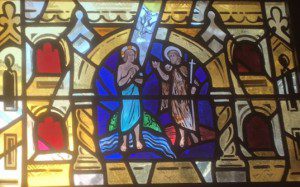
Jesus and the children (Mark 10:13-16)
The children are drawn from all the races of the earth.
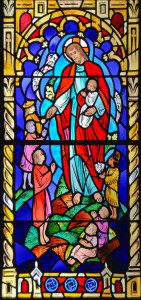
John Calvin (1509-1564)
The French reformer and head of the Reformed Branch of Protestantism, combined theology with his political leadership in Geneva. His Institutes established him as a theological leader of Reformation.

Fourth Lancet
Jesus tempted in the wilderness (Matthew 4:1-11)
The devil shows Jesus all the kingdoms of the earth (v. 8) and Jesus replies, “Begone, Satan” (v. 10).
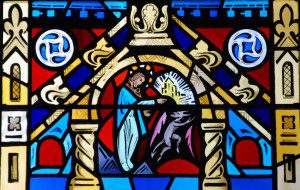
John, the Writer of the Book of Revelation (Rev. 6:1-7)
Chapter 6, verses 1-7 describes the four horsemen. The rider of he white horse wears a crown; the rider of the red horse holds the sword of war; the skeleton on the pale horse is death; and the rider on the black horse, pestilence, holds the balance scales, the judgement of good and evil.
The local monarch butterfly decorates the corners of the panel.

St. Peter, the Fisherman (Matthew 16:19)
St. Peter toils at his craft. Pictured with him are the keys of the kingdom of heaven granted to him by Jesus.
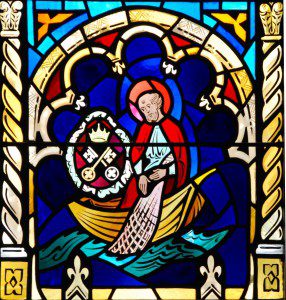
The First Pilgrim Thanksgiving
The First Pilgrim Thanksgiving is depicted at Plymouth in 1621. The local sea otter decorates the upper corners.
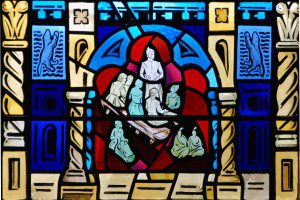
Rear Nave Window
Fifth Lancet
Jesus Teaching the Sermon on the Mount
Found in Matthew 5, 6 & 7)

Martin Luther (1483-1546)
The German reformer nailing his 95 theses of protest on the door of the chapel at the University of Wittenberg on the first of November, 1517. The academic debate which ensued was the beginning of the Reformation.
The California poppy decorates the upper corners.
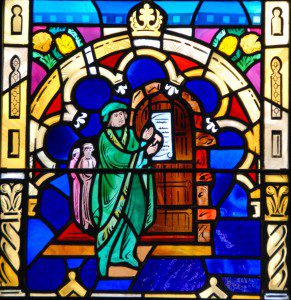
John Wesley (1702-1791)
John Wesley founded the Methodist Church, whose beginnings date from Wesley’s first meetings in 1736. His mother, Susanna, who profoundly influenced him, stands in the background.
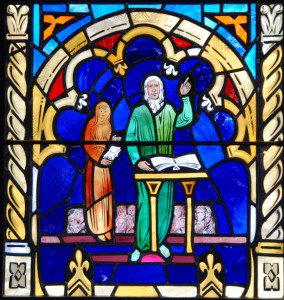
Father Junipero Serra (1713-1784)
Father Serra established missions a day’s journey apart throughout the length of California. Here he stands in front of his beloved Carmel Mission where he is buried.
The California grey whale decorates the upper corners.
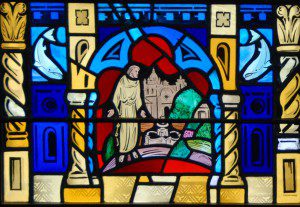
Sixth Lancet
Jesus
Jesus used several methods of healing, one of which is depicted in Mark 8:22-26 where he touches the eyes of a blind man.
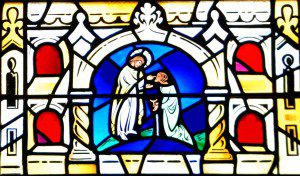
St. Paul
St. Paul, the greatest apostle, whose writings forever shaped Christianity and whose missionary journeys spread the Gospel throughout the Roman Empire, is caught in a storm (Acts 27). Four orange sea anchors trail behind the ship. In the corner sits a Roman centurion.
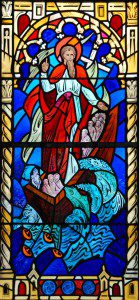
Charles Wesley (1707-1788)
Charles Wesley was the hymn writer of Methodism, producing about 6,500 lyrics. Charles is considered by many to be the greatest hymn writer of all ages. Seventy-seven of his hymns are in the current Methodist Hymnbook.
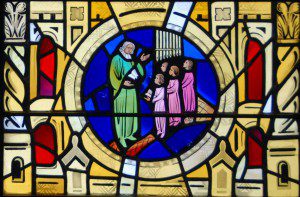
Seventh Lancet
Jesus’ Entry into Jerusalem (Mark 11:1-11)
Jesus enters Jerusalem in the beginning of Holy Week.
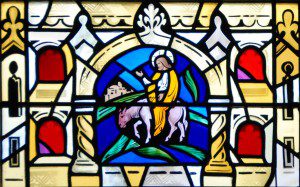
Moses (Exodus 19, 20)
The towering Old Testament figure, receiving the Ten Commandments. Aaron, his brother the High Priest stands by with the rod in his hand.
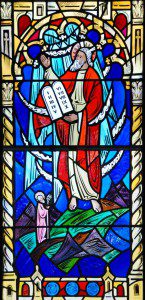
Francis Ashbury (1745-1816)
The “prophet of the long road,” was Wesley’s apostle to America. He crisscrossed the eastern United States covering perhaps 275,000 miles on horseback, passing over the Allegheny mountains sixty times. he was American Methodism’s first Bishop.

Eighth Lancet
Jesus and His Disciples (mark 14)
Jesus and His disciples join together for the Last Supper in Bethany.
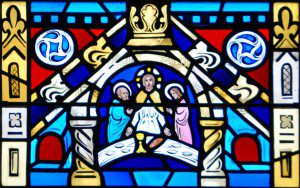
The Prophet Daniel (Daniel 6)
The prophet Daniel, a captive Israelite of high rank in the Persian court, is the victim of a plot by jealous courtiers and is cast into the den of lions by King Darius and miraculously survives through God’s protection.
Local deer adorn the upper corners of the window.
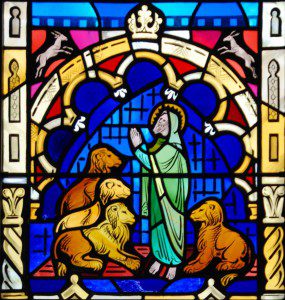
The Prophet Jeremiah (Jeremiah 18)
The prophet Jeremiah goes to the potter’s house and draws a parable of Israel represented by the clay, being worked by the potter, God. Jeremiah is the prophet of personal religion.
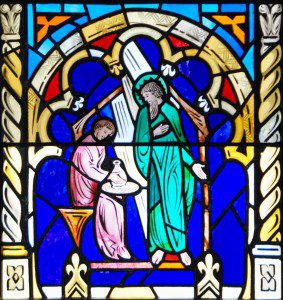
Florence Nightingale (1820-1910)
Florence Nightingale revolutionized nursing practices in England, established a major nursing school, and was widely acclaimed throughout the world. She is pictured, lamp in hand, working at the Scutari Hospital in the Crimea in 1854.
Hummingbirds decorate the upper corners of the window.
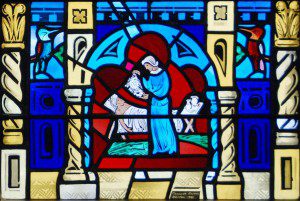
The Garden Window
Ninth Lancet
Jesus Prays (Mark 14:32-42)
Jesus prays in great agony in the Garden of Gethsemane prior to his arrest.
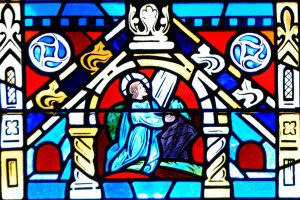
Adam and Eve (Genesis 3)
Adam and Eve are driven from the Garden of Eden after disobeying God’s command and the flaming sword is placed by God to bar them from re-entry and from the tree of life. The serpent watches the event and the apple, the symbol of their disobedience, lies on the ground.
Fuchsias decorate the upper corners of the window.
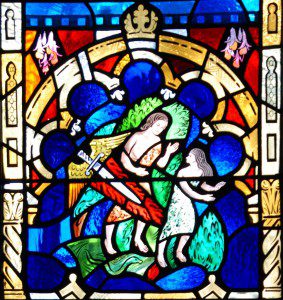
God Destroys the World by Flood (Genesis 6, 7, 8)
God destroys the world by flood because of man’s sin, saving Noah and his family. Noah builds the ark in which two of all species on earth are preserved. A dove sent aloft on the forty-seventh day returns with an olive branch, symbolizing the end of the flood.

Isabella Thoburn
Isabella Thoburn was the first woman missionary to India sent in 1869 by the Woman’s Foreign Missionary Society. She founded Lucknow University plus three high schools, three hospitals, four boarding schools, a home for the crippled, and seventy day schools. She is pictured in front of the Taj Majal. She died in 1901 of cholera.
Artichokes decorate the upper corners.
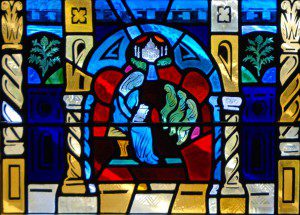
Tenth Lancet
The Crucifixion of Jesus (Mark 15)
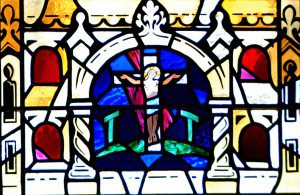
Abraham (Genesis 22)
Abraham is put to the test by God as he is required to sacrifice his only son, Isaac, on Mt. Moriah. As he is about to plunge his knife into the boy, the angel tells him to stop. Abraham sees a ram caught in a thicket which is offered up instead of the boy. Sarah, Abraham’s wife, waits anxiously at home.
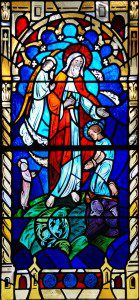
William Taylor
William Taylor was an early Methodist preacher in San Francisco who preached at Union Square, helped by his petite wife. Taylor Street is named for him. After seven years in California, Taylor went to Australia, returning with eucalyptus seedlings which introduced the tree to California. Then he went to South Africa, the West Indies, Ceylon, India, Africa and South America. As a retired layman he was elected Bishop of Africa and served twelve years in Liberia. In the window, Bishop Taylor stands in front of the Golden Gate with a eucalyptus tree at his side.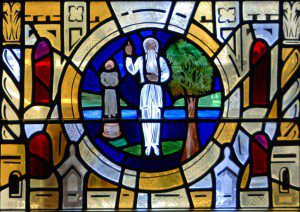
Eleventh Lancet
Jesus Triumphantly Emerges from the Tomb (Luke 24, John 20)
Jesus triumphantly emerges from the tomb in this scene of resurrection.
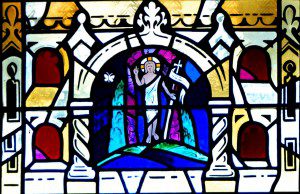
The Flight into Egypt (Matthew 2:13-23)
Joseph, Mary and Jesus leave Judea, having been warned of Herod’s rage, and escape the “Slaughter of the Innocents.”
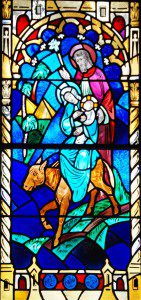
Albert Schweitzer (1875-1965)
Albert Schweitzer, doctor, missionary, scholar, minister and musician, stands at the pinnacle of twentieth century western civilization.
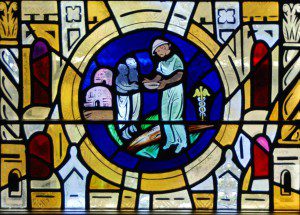
Twelfth Lancet
At Pentecost (Acts 2)
At Pentecost, the Holy Spirit of the risen Christ descended upon the disciples as tongues of fire. The dove is the symbol of the Holy Spirit.
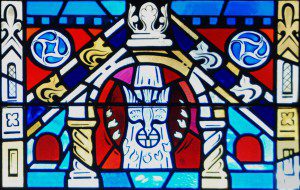
St. Francis of Assisi (1181-1226)
St. Francis of Assisi who gave up all worldly goods to live in poverty and founded the Franciscan Order, was such a lover of nature and animals he was said to speak with them – even the wolf of Gubbio was calmed by his sweet spirit. He was canonized in 1228.
Mission bells are in the corners.
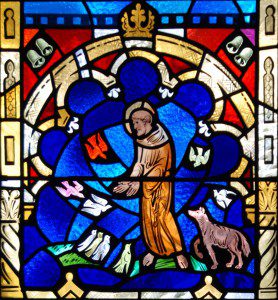
Isaiah, the Royal Prophet (Isaiah 6)
Isaiah, the royal prophet described in his prophetic summons in the temple at Jerusalem. In an awesome vision he sees the Almighty God and is overcome by a sense of his sinfulness. Absolution is given when a seraphim holding in tongs a live coal from the altar touches it to his lips.

The Church of the Wayfarer
The Church of the Wayfarer, Carmel-by-the-Sea’s first church, was founded in 1904 and has been on its present site since then.
California redwoods appear in the corners.
